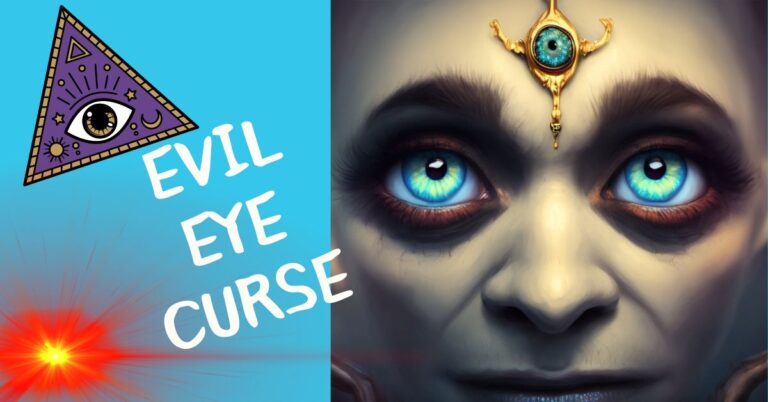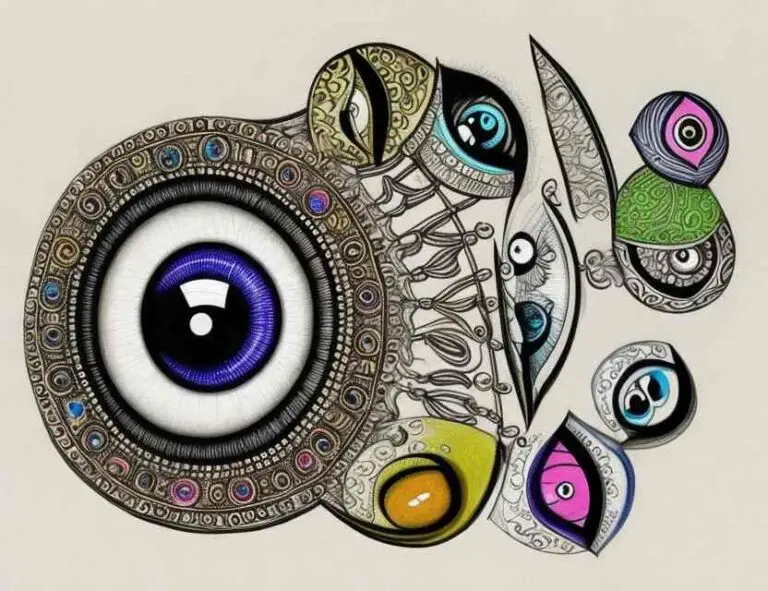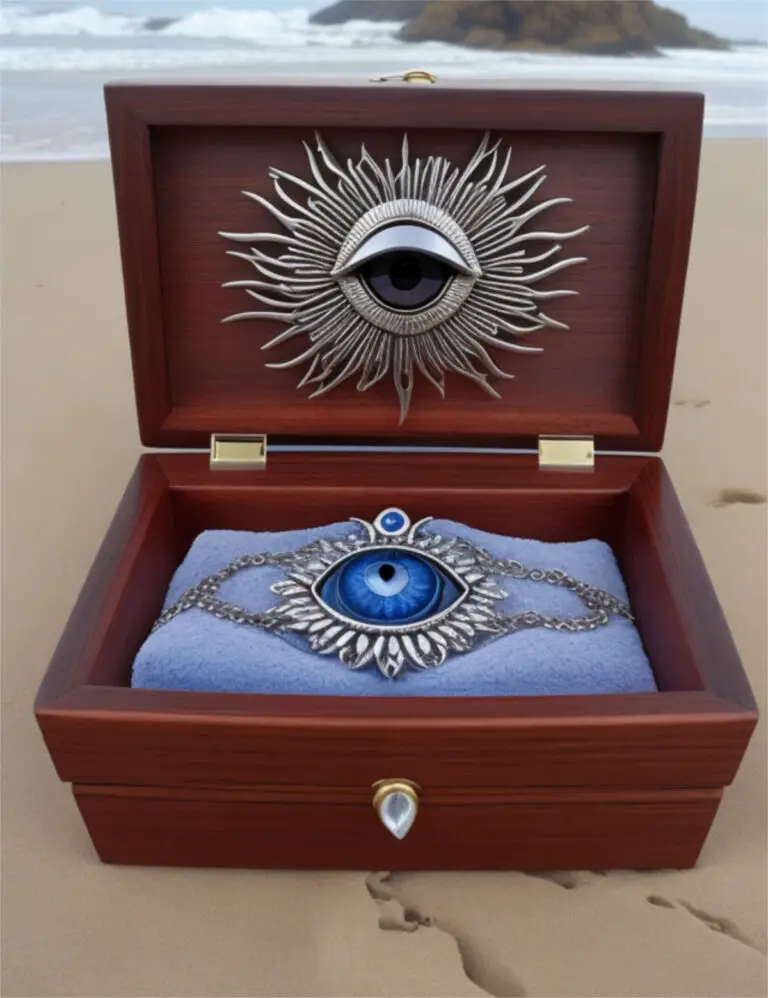Does The Evil Eye Protect You? Must Read!
HobbyistGeek.com is a member of the Amazon Services LLC Associates Program, a program designed to allow websites to earn advertising fees by promoting and linking to Amazon.com.

The evil eye has fascinated globally as both a curse and protection.
This article explores the myth and reality of using the evil eye as defense against misfortune, comparing cultures and analyzing if it genuinely shields or just transformed from feared curse into trendy amulet.
Introduction
Does The Evil Eye Protect You? Throughout history, various cultures have held firm beliefs in the existence and potential harm caused by an enigmatic phenomenon known as the Evil Eye. This deeply rooted belief has captivated the imagination of people across different continents, transcending time and space. But what exactly is the Evil Eye?
How does it function? And most importantly, can it truly protect us?
A Gaze that Wields Dark Power
The concept of the Evil Eye revolves around an ancient belief that certain individuals possess supernatural powers through their gaze alone. It is believed that these individuals have the capability to cast malevolent glances upon others, ultimately causing them misfortune, illness, or even death. The notion of this ominous power is not confined to a singular culture or region; rather, it permeates diverse societies across the globe.
A Tapestry of Cultural Beliefs
Cultural interpretations and superstitions surrounding the Evil Eye vary significantly from one community to another. In some countries like Greece, Italy, and Turkey, people firmly believe that envious or ill-intentioned glares can bring forth extreme adversity in a person’s life. By contrast, other cultures view it as more than just a supernatural force but rather a symbol of protection against such negative impacts.
Superstitions abound when discussing the Evil Eye. Some believe that newborn babies are particularly vulnerable to its influence and must be shielded with amulets or talismans right from birth.
Others hold onto customs like spitting on themselves or their belongings as a way to deflect any potential negative energy cast by an envious observer. This article sets out on a journey to explore the historical origins of this intriguing belief system while delving into its mechanisms and protective measures employed by different cultures throughout time.
Historical Origins of the Evil Eye
Ancient Mesopotamian and Egyptian Beliefs
The concept of the Evil Eye has deep roots in ancient civilizations such as Mesopotamia and Egypt. In these cultures, it was believed that certain individuals possessed the power to cast a malevolent gaze upon others, causing harm or misfortune.
In Mesopotamia, this belief was intertwined with astrology, as they believed that celestial events could influence the Evil Eye’s power. Meanwhile, in Egypt, the concept of the Evil Eye was closely linked to their beliefs about magic and witchcraft.
Influence of Greek and Roman Civilizations on the Concept
The Greek and Roman civilizations played a significant role in shaping and popularizing the idea of the Evil Eye. The Greeks believed that envy and jealousy could manifest as a powerful gaze capable of inflicting harm upon its recipients. They considered it an innate ability possessed by both gods and mortals.
Moreover, Greek literature is replete with references to this malevolent influence, including works by famous writers like Homer and Plato. Later on, during the Roman era, the concept was further expanded upon.
The Romans attributed certain amulets or talismans with protective qualities against the Evil Eye’s harmful effects. These objects were often worn or displayed prominently as a means of warding off any ill intentions directed towards them.
Spread of the Evil Eye Belief across Different Cultures
Over time, belief in the power of the Evil Eye spread far beyond its original ancient origins. As trade routes expanded between different regions around the globe, so too did cultural exchanges regarding this supernatural phenomenon.
For instance, through trade networks established by Phoenician merchants in ancient times, knowledge about this belief system reached various parts of Europe and even further eastward into Asia Minor. Similarly, during Alexander the Great’s conquests, the idea of the Evil Eye was disseminated throughout his vast empire, leaving an indelible mark on different cultures.
In India, the concept of drishti or “casting an evil eye” developed independently, yet shared similarities with its counterparts in other regions. The belief in the Evil Eye also found its way to other cultures like Persia, where it became intertwined with Islamic traditions and practices.
The widespread adoption of this belief demonstrates humanity’s enduring fascination with supernatural forces and our collective desire to find explanations for misfortune or adversity. Today, despite varying interpretations and cultural nuances, the Evil Eye remains a captivating topic that continues to capture our imagination across numerous societies worldwide.
Understanding the Mechanism of the Evil Eye
Different interpretations: envy, malevolent gaze, or supernatural power?
The concept of the Evil Eye has been interpreted in various ways across cultures and traditions. Some believe that it is caused by envy, stemming from feelings of jealousy or ill-will towards others. According to this interpretation, when someone looks at you with envy, their negative energy can harm or affect you negatively.
Others ascribe a more sinister meaning to the Evil Eye, considering it as a malevolent gaze intentionally directed towards an individual to cause harm or misfortune. In some cultures, people attribute supernatural powers to individuals who possess the ability to cast an Evil Eye and cause harm with just a glance.
Psychological explanations for its effects on individuals
Psychologists have sought to explain the effects attributed to the Evil Eye from a scientific standpoint. One psychological explanation suggests that when someone believes they have been affected by the Evil Eye, it triggers stress and anxiety.
This heightened state of fear can negatively impact both mental and physical well-being. It is believed that this psychological distress can manifest itself in various ways such as headaches, fatigue, sleep disturbances, or even depression.
Role of belief and perception in shaping its impact
Belief plays a crucial role in how individuals perceive and experience the effects of the Evil Eye. Studies have shown that those who strongly believe in its existence are more likely to attribute negative events or misfortunes to its influence. This phenomenon is known as confirmation bias – our tendency to interpret information in a way that confirms our existing beliefs.
Perceptions are subjective; some people may be more susceptible due to their cultural upbringing and deeply ingrained belief systems. Additionally, cultural factors shape perceptions of the Evil Eye’s impact differently across societies.
For instance, societies where belief in witchcraft is prevalent tend to attribute misfortune to the Evil Eye more readily. On the other hand, societies with a scientific or secular outlook might dismiss it as mere superstition.
Thus, the influence of the Evil Eye heavily depends on an individual’s belief system and their cultural context. The mechanism of the Evil Eye is multifaceted and subject to various interpretations.
It can be seen as an envious gaze, a malevolent intention, or even supernatural power in some beliefs. Psychological explanations highlight how stress and anxiety can result from the fear of being affected by it.
The role of belief and perception cannot be overlooked either since they shape individuals’ experiences and reactions to its alleged effects. As we delve deeper into this fascinating topic, it becomes clear that understanding the Evil Eye necessitates exploring cultural beliefs alongside psychological perspectives.
Protective Measures against the Evil Eye
When it comes to safeguarding oneself from the malevolent influences of the Evil Eye, various cultures have devised an array of protective measures. One prevalent method is the use of talismans and amulets, believed to ward off ill intentions and protect individuals from harm. Among the most popular talismans are the Nazar, Hamsa, and Hand of Fatima.
Talismans and Amulets
The Nazar, commonly seen in Mediterranean cultures, takes the form of an eye-shaped amulet made from blue glass or ceramic. The design often features concentric circles or a blue center with curling patterns resembling an iris.
It is believed that this highly stylized eye deflects evil intent by drawing negativity towards itself before it reaches its intended target. In contrast, the Hamsa – also known as the Hand of Fatima – is a hand-shaped amulet adorned with various symbols such as eyes, fish, or floral motifs.
Originating from ancient Mesopotamia and Egypt, this talisman represents protection against evil forces. The five fingers symbolize different blessings: strength, faithfulness, vitality, abundance, and protection.
The Hand of Fatima’s significance spans across different cultures; it serves as a powerful symbol for Jews and Muslims alike. Its design differs regionally: some versions feature additional charms or inscriptions while others emphasize simplicity in their aesthetics.
Symbolic Meanings
These protective charms carry deep symbolic meanings that resonate within their respective cultural contexts. The Nazar’s blue color represents purity and clarity while its eye shape emphasizes vigilance against negative energy. In Turkish culture specifically, it is believed that breaking a Nazar amulet indicates its successful interception of harmful intentions.
The Hamsa, on the other hand, embodies a broader range of symbolism. The open palm represents blessings, abundance, and power.
The eye embedded within it symbolizes divine protection and watches over its bearer. The combination of these elements creates a potent defense against the Evil Eye’s influence.
Cultural Variations
While the general concept remains consistent across cultures, there are notable variations in how talismans and amulets are designed and utilized. For instance, in Greece, the Mati is a blue-eyed amulet that bears resemblance to the Nazar but often features additional charms such as a cross or heart-shaped elements. Similarly, in Iran and parts of South Asia, people wear amulets known as Taweez which contain intricate calligraphy verses from religious texts.
These cultural variations highlight the diversity in beliefs surrounding protection from the Evil Eye. From specific designs to personalized rituals associated with these talismans and amulets – such as wearing them as jewelry or displaying them prominently in homes – each culture has its own unique practices that enhance their effectiveness.
Rituals and Practices to Ward off the Evil Eye
Rituals involving salt, water, or herbs for purification purposes
In many cultures, rituals have been developed to protect against the malevolent effects of the Evil Eye. These rituals often involve the use of natural elements such as salt, water, or herbs. Salt is widely regarded as a powerful cleansing agent and is believed to absorb negative energy.
It is commonly used in various forms, such as sprinkling salt around a person’s living space or adding it to bathwater for spiritual purification. Water is also considered a purifying element in many traditions.
To counteract the influence of the Evil Eye, people might perform ablution rituals where they wash their hands and face with blessed water. This practice aims to cleanse oneself from any negativity that might have been transmitted through envious glances.
Use of salt as a cleansing agent in different cultures
The use of salt as a protective measure against the Evil Eye can be traced back to numerous ancient civilizations. For instance, in Roman culture, people would sprinkle salt on doorways and windowsills to create a barrier against negative energies entering their homes. Similarly, in Greek culture, it was common for individuals to toss handfuls of salt over their shoulders after encountering someone who they suspected had cast an evil eye upon them.
In Indian folklore, rock salt (also known as Sendha Namak) holds significance in protecting against evil influences. People place small bowls filled with rock salt near entrances or within rooms to ward off any negative energy that may be lingering around.
Herbal remedies believed to repel negative energy
Apart from salts and waters, various herbs are also believed to possess protective properties against the Evil Eye. For centuries, people have utilized specific plants known for their purifying qualities. One such herb is rue, commonly referred to as “herb of grace.” It is often burned or worn as an amulet to ward off the Evil Eye.
Similarly, sage, lavender, and rosemary are considered powerful herbs for cleansing spaces and dispelling negative energy. In certain cultures, individuals may prepare herbal concoctions or infusions that can be consumed or applied externally for protection against the Evil Eye.
These mixtures often include ingredients such as basil, mint, thyme, and rose petals. The belief is that these plants possess inherent abilities to repel negativity and create a shield of positive energy around the person.
Overall, rituals involving salt, water, and herbs have a long-standing tradition in various cultures as protective measures against the perceived malevolence of the Evil Eye. While their effectiveness may vary depending on individual beliefs and cultural contexts, these practices continue to be embraced by many who seek to safeguard themselves from envious glances and negative energies.
The Role of Belief in Protection from the Evil Eye
The Power of Positive Thinking and Self-Confidence
When it comes to warding off the malevolent effects of the Evil Eye, belief holds a significant role. Many cultures believe that one’s state of mind and attitude can act as a shield against negative energy. The power of positive thinking and self-confidence is touted as an effective defense mechanism.
Positive thinking, in this context, involves maintaining an optimistic outlook on life and refusing to dwell on negativity. It is believed that by keeping a positive mindset, individuals can create a protective barrier that repels any harmful energy directed towards them.
When faced with envy or malicious intentions, those who practice positive thinking remain resilient and unaffected. Self-confidence is another crucial aspect in safeguarding oneself against the Evil Eye’s influence.
By believing in their own worth and abilities, individuals build an aura of strength around them. This confidence acts as an invisible shield that deflects negativity, ensuring it doesn’t penetrate their well-being.
Cultural Practices Promoting Positivity to Counteract Negativity
Various cultures have developed practices aimed at promoting positivity to counteract negativity caused by the Evil Eye. These practices often involve rituals or customs designed to bring about good fortune and repel negative energy.
For instance, in some Eastern Mediterranean countries like Greece and Turkey, people may perform rituals involving salt or water for purification purposes. Sprinkling salt around the house or taking a ritual bath with water infused with specific herbs are believed to cleanse one’s surroundings from any malevolence caused by the Evil Eye.
In addition to these purification rituals, cultural practices such as gratitude exercises or meditation are prevalent in many societies. By cultivating gratitude for what they have instead of focusing on what they lack, individuals embrace positivity and create resilience against external negativity.
Furthermore, religious practices play a significant role in promoting positivity. Prayers, affirmations, and religious ceremonies are believed to invoke divine protection and strengthen the individual’s defense against the Evil Eye.
Ultimately, whether through positive thinking or cultural practices promoting positivity, the belief in protection against the Evil Eye becomes a powerful tool in safeguarding oneself from its harmful effects. By actively embracing positive energy and maintaining an optimistic outlook, individuals can create their own shield of resilience that helps them navigate through life unharmed by envy or ill-intentioned gazes.
So remember, when it comes to the Evil Eye, belief truly holds sway over its influence. Embrace positivity, nourish self-confidence, and let your inner resilience shine forth – for it is in these qualities that protection from the Evil Eye finds its stronghold.
Modern Perspectives on the Evil Eye
Scientific skepticism towards its existence
In today’s rational and scientific world, the concept of the Evil Eye is often met with skepticism. Many argue that there is no concrete evidence to support its existence or its alleged effects on individuals. Skeptics view it as nothing more than a superstition or a product of cultural beliefs and folklore.
They claim that the Evil Eye holds no real power and that any perceived effects are merely coincidental or influenced by psychological factors. Scientists propose alternative explanations for experiences attributed to the Evil Eye.
They suggest that when someone believes they have been affected by it, it may be due to a combination of psychological factors such as anxiety, stress, or heightened suggestibility. These factors can influence an individual’s perception and contribute to feelings of discomfort or misfortune.
Critics also argue that attributing misfortunes solely to the Evil Eye ignores other possible causes such as natural phenomena, random events, or personal choices. They advocate for a more rational approach in analyzing life’s ups and downs, encouraging individuals to look for logical explanations and take responsibility for their own actions rather than blaming external forces like the Evil Eye.
Popularity in popular culture: movies, books, and art
Despite scientific skepticism surrounding the concept of the Evil Eye, it remains incredibly popular in various forms of popular culture. It has captured the imaginations of filmmakers, writers, artists, and musicians alike.
The intrigue surrounding this ancient belief has provided ample fodder for creative expression. In movies and television shows, we often see references to characters having an evil gaze capable of bringing harm upon others through envy or jealousy — reminiscent of the idea behind the Evil Eye.
These portrayals serve both as entertainment and a reflection of cultural beliefs ingrained in our collective consciousness. Books exploring themes around supernatural powers often incorporate aspects related to the Evil Eye.
Authors employ it to add an air of mystery, intrigue, and danger to their narratives. The idea that a single malevolent glare can affect the destinies of individuals creates tension and excitement within the storyline.
Artworks inspired by the Evil Eye are found across different mediums and cultures. Paintings depicting protective talismans or captivating eyes with symbolic meanings adorn galleries and homes globally.
Jewelry designers create exquisite pieces featuring the iconic symbol, allowing people to wear their beliefs as a form of personal expression. While scientific skepticism challenges the existence of the Evil Eye and its alleged effects, its popularity in popular culture remains undeniably strong.
Whether seen as a fascinating aspect of folklore or believed to hold genuine power, the concept continues to captivate our collective imagination through movies, books, art, and more. Regardless of one’s personal beliefs or perspectives on its validity, it is undeniable that the Evil Eye is deeply ingrained in many cultures worldwide, serving as a testament to its enduring allure in modern times.
Examples from Different Cultures
Greece: Mati – The Blue-Eyed Amulet
In Greece, the belief in the Evil Eye runs deep, and one of the most commonly used protective charms is the Mati, also known as the blue-eyed amulet. This small charm, usually made of blue glass or stone, resembles an eye and is believed to have powerful protective properties. It is often worn as jewelry or displayed in homes and shops.
The Mati holds great significance in Greek culture, as it symbolizes a watchful eye that wards off evil and brings good luck. Many Greeks believe that when someone praises or admires them excessively, it may inadvertently cast an evil gaze upon them.
To counteract this potential harm, they turn to the Mati for protection. The charm’s penetrating blue color is said to distract and deflect any negative energy directed at its wearer.
Turkey: The Nazar Boncugu – The All-Seeing Eye
Similarly, in Turkey, they have their own version of a protective amulet called the Nazar Boncugu or the all-seeing eye. This striking talisman features concentric circles of blue and white resembling an eye. It is widely believed to protect against the Evil Eye by absorbing malevolent gazes directed towards its bearer.
The Nazar Boncugu has a long-standing presence in Turkish culture and can be found adorning everything from jewelry to home decorations. Parents often place these amulets on their newborns’ clothing or attach them to strollers to safeguard their infants from envious glances that might bring harm.
Conclusion for Does The Evil Eye Protect You?
Throughout history and across different cultures, belief in the power of the Evil Eye has persisted despite scientific skepticism. While there may not be concrete evidence supporting its existence or efficacy as a form of protection against negative energy, the cultural significance of amulets like the Mati and Nazar Boncugu cannot be denied. These symbols serve as reminders to cultivate positivity, ward off envy, and focus on the good in our lives.
Whether or not one subscribes to the belief in the Evil Eye, there’s value in recognizing that our thoughts and intentions have a profound impact on our well-being. By cultivating optimism, practicing self-confidence, and fostering positive relationships with others, we can create a protective shield against negativity that may come our way.
In the end, it is important to remember that belief systems shape cultures and contribute to a sense of comfort and security. So whether you choose to wear an amulet or simply embrace positive thinking, let’s celebrate the human capacity for resilience and hope.
1. Are all Evil Eye amulets equally effective?
When it comes to Evil Eye amulets, their effectiveness can vary depending on various factors.
The design, materials used, and cultural significance can all play a role in how potent the amulet is believed to be. Some people prefer traditional handmade amulets passed down through generations, while others find comfort in modern interpretations crafted with precision.
Ultimately, the efficacy of an Evil Eye amulet relies on an individual’s belief and connection to the symbol.
2. Can wearing Evil Eye jewelry protect against the curse?
Evil Eye jewelry has gained popularity worldwide as a fashionable way to ward off negativity. While some may consider it purely an aesthetic choice, others firmly believe in its protective powers.
The jewelry typically features the iconic blue and white eye symbol, which is thought to repel harmful energies cast by the Evil Eye. Whether you choose a simple necklace or an intricate bracelet adorned with Evil Eye charms, wearing them can serve as a personal talisman that provides a sense of security.
3. How do rituals help in averting the effects of the Evil Eye?
Various cultures have developed specific rituals aimed at protecting individuals from the malevolent gaze of the Evil Eye.
These practices often involve reciting prayers or performing symbolic gestures to ward off negative energy. For instance, burning incense or using specific herbs like sage are believed to purify spaces and create a shield against psychic harm.
These rituals provide psychological reassurance and reinforce one’s faith in protection from the evil forces.
4. Is belief in the Evil Eye purely psychological?
While skeptics may dismiss belief in the Evil Eye as mere superstition without any scientific basis, it is important to recognize that psychology plays a significant role in shaping our perceptions and experiences of reality. Believing in something can influence our thoughts and behaviors, leading us to interpret events through that lens.
In this context, belief in the Evil Eye can offer a psychological sense of protection and comfort, creating a mindset that repels negative energies.
5. How does belief in the Evil Eye vary worldwide?
The concept of the Evil Eye is not limited to one specific culture or region. It spans across continents and has different interpretations and practices globally.
Some cultures believe in warding off the Evil Eye through amulets and talismans, while others focus on rituals involving prayers and protective gestures. Comparing these beliefs can reveal fascinating cultural variations and shed light on how people modify their practices to suit their unique backgrounds.
Check Out this article: Why Evil Eye is Blue? The Secret Science That Links its Color to Protection!
- Evil Eye Hand: Unveiling the Mystical Origins and Meanings - February 2, 2024
- Amegreen Amethyst Meaning: Discover the Hidden Magic! - February 2, 2024
- Is The Evil Eye Bad?: A Deep Dive into Evil Eye Taboos - February 2, 2024








